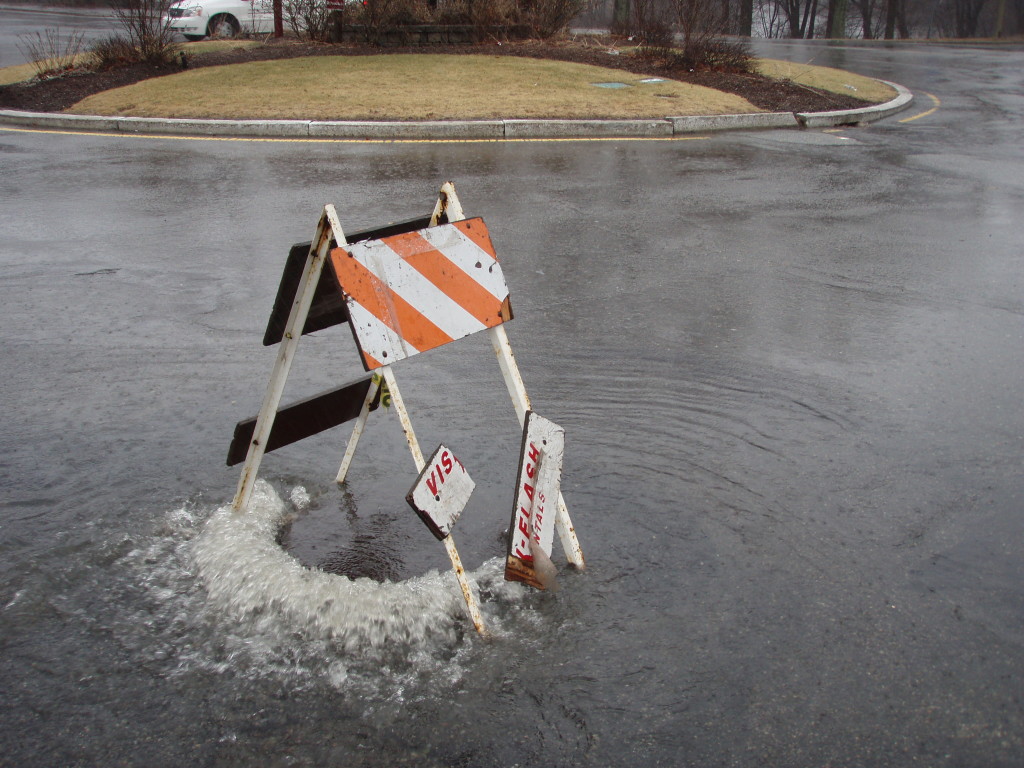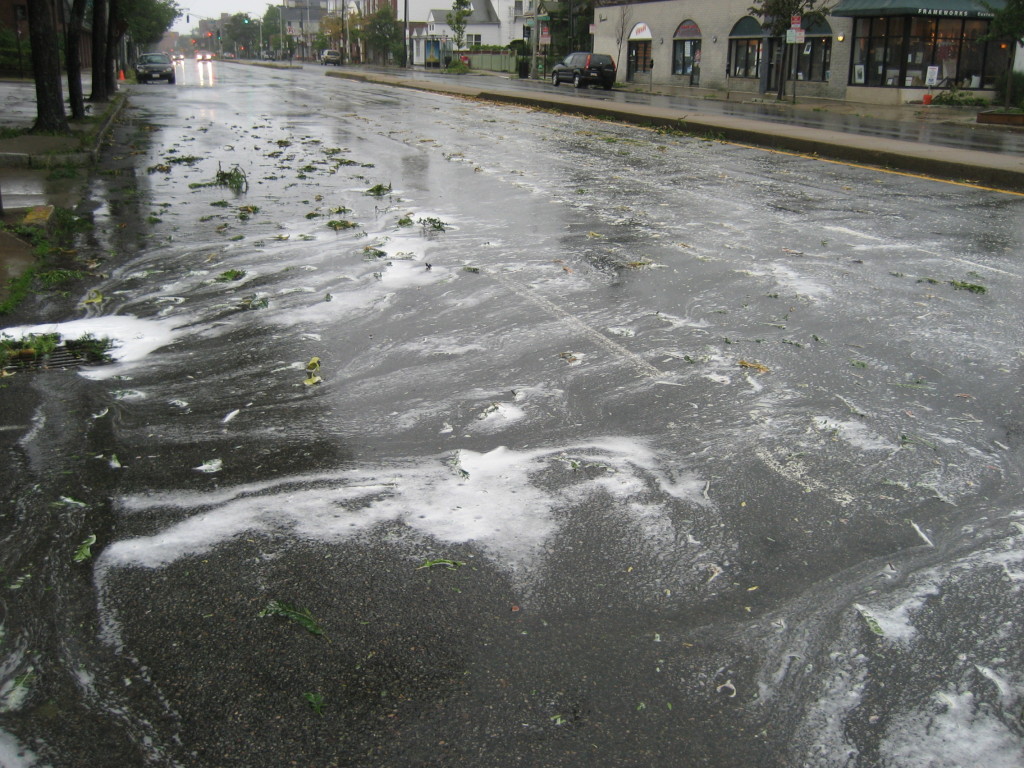by Nancy Hammett
Belmont, like other urban communities throughout the country, must obtain a “permit” under the Federal Clean Water Act in order to discharge water from its storm drains into local streams and ponds. This permit (the “Municipal Separate Storm Sewer System” or “MS4” permit) imposes a number of responsibilities on the town. These requirements have been in effect in Massachusetts since 2003 and a new version of the permit is in the offing.
The federal Environmental Protection Agency (EPA) expects to issue the new regulations by the end of this year, and they will take effect six months later. The town will then have 90 days to submit a permit application including a description of how it will comply with the permit requirements. Belmont will have a year to prepare a detailed Stormwater Management Plan.
Stormwater pollution comes from many sources. Rainwater and melting snow pick up a variety of harmful substances as the water flows over land and through the storm drain system including trash, pet waste, oil and grease, leaf litter, detergents, pesticides, and fertilizers. That pollution ends up in local rivers, ponds, lakes, and streams.
Sewage also can get mixed with stormwater through leaky pipes or illegal connections of sewer pipes to storm drains or of sump pumps to sewer lines. Some people dump toxic materials into the storm drains—old paint, used oil, and the like—mistakenly thinking that the contents will be treated somewhere down the line. In fact, Belmont’s stormwater is not treated. Instead, it is discharged directly into Wellington Brook, Winn Brook, and other local waterways. Ultimately, Belmont’s stormwater will drain to the Mystic River and the Charles River. Pollutants are only removed from stormwater when stormwater is filtered by clean soil before the liquid arrives at a stream or pond.
Given these ubiquitous sources of stormwater pollution, successfully controlling the problem requires action by many parties: the town itself, businesses and other property owners, and residents. Under the MS4 permit, the town is responsible for promoting improvements in developer, business and resident practices as well as controlling the impact of town activities.
The 2003 permit established six broad requirements:
1. Public Outreach & Education: Educate the public about the impacts of stormwater discharges and about steps the public can take to reduce impacts.
2. Public Participation: Provide opportunities for the public to provide input on the stormwater program and to participate in various ways.
3. Illicit Discharge Detection & Elimination (IDDE): Find and correct illicit discharges of pollutants via stormwater. This task includes both mapping the storm drain system and regular monitoring for pollution at outfalls where the storm drain system discharges water to local streams or ponds. When bacteria or other pollutants are found, the town must systematically investigate the drain system to locate the sources of the contamination, and take steps to correct the problems.
4. Construction Site Runoff Control: The town must prevent erosion and runoff of pollutants from construction activities that disturb more than one acre of land, through a bylaw or other mechanism.
5. Post-Construction Stormwater Management Requirements: The town must establish requirements for stormwater management in new development and redevelopment where sites disturb more than one acre.
6. Municipal Pollution Prevention and Good Housekeeping: The town must reduce stormwater impacts from its own operations, including operations & maintenance plans for parks, vehicles, buildings, roads, and the stormwater system, and conduct employee training.
The town’s MS4 5-year permit formally expired in 2008, but has continued in effect as the EPA has worked to issue finalize regulations. A proposed new permit was published in 2010. A second proposal was released in September 2014, with some changes in response to the numerous comments received on the 2010 proposal. Until a new permit is adopted, the 2003 permit is still in effect.
Given the broad scope of the 2003 permit, it is not surprising that many Massachusetts cities and towns have struggled to meet its requirements. The proposed new permit includes more explicit deadlines, some additional requirements, and expanded reporting requirements. At the same time, it attempts to preserve flexibility in planning and priorities. In addition, the proposed permit includes extended deadlines for some of the more difficult requirements.
The 2014 version of the permit includes some new or expanded requirements; a few are listed below. You can find a more complete description of the continuing and new requirements at the web link cited above.
1. More public outreach and education, requiring targeted messages for four audiences (residential, industrial, commercial/business, and construction/development) and evaluation of the education program’s effectiveness.
2. More detailed requirements and deadlines for the IDDE program, including detailed mapping of the system (catch basins, manholes, pipes and sensitive water resource areas), written protocols for assessing and prioritizing areas for investigation, and deadlines for addressing problem areas. The proposed permit also requires an inventory of sanitary sewer overflows (SSOs).
3. A comprehensive construction site program including pre-construction review of construction sites, site inspection and enforcement, and opportunities for public input.
4. Enhanced requirements for new development and redevelopment including a bylaw requiring sites to hold and infiltrate a specific quantity of rainfall onsite. Where that infiltration is not feasible, sites must treat that rainfall before discharging it to the storm drain system.
5. The town must assess its street and parking lot design standards and regulations to identify impediments to Low Impact Development and green infrastructure approaches.
6. The town must calculate and track changes in the areas that are impervious areas (sidewalks, roads, parking lots and roofs that prevent water from soaking in to the soil) and that run off directly into the town’s storm system. The town must also evaluate opportunities on town-owned properties to reduce these directly-connected impervious areas.
7. The town must also develop specific plans for dealing with pollutants that cause local waters to fail the state’s water quality standards for those pollutants. For some pollutants (e.g. bacteria), plans will involve earlier deadlines for the general permit requirements. In other cases (e.g. phosphorus), broader efforts will be required to control the impact of land uses. Extended deadlines are provided for these challenging requirements. However, it’s important that the town prevent any increases in pollution from new development, starting now, to avoid making it harder to comply with these requirements in the future.
There is no doubt that Belmont will need to step up its efforts to comply with the new permit requirements. Other communities face the same challenge. Municipalities are looking for cost-effective ways to comply with the permit including promoting Green Infrastructure approaches (see “Green Infrastructure Grant to Reduce Pollution,” BCF Newsletter September/October 2013) and finding new ways to fund expanded programs such as by establishing a dedicated stormwater fee. Some Massachusetts communities are also forming regional groups to save costs by sharing resources and information.
Belmont residents can expect to hear a lot more about stormwater issues in the next few years. The town will be expanding efforts to educate homeowners, businesses, and other property owners about how their activities contribute to polluted stormwater and about the wide range of steps they can take to reduce their impacts on local waters.
What’s at stake? Stormwater pollution is the most common cause for Massachusetts streams and lakes failing to meet water quality standards. In many places, including Belmont, stormwater is the last major source of pollution standing in the way of clean and healthy local streams, lakes, ponds, and rivers.
If all communities simultaneously make serious efforts to control their stormwater pollution, we have a chance to finally make shared local streams and lakes swimmable, boatable, and healthy homes for wildlife. That is the goal of the proposed MS4 permit.
For more details, see this Summary of Current and Proposed MS4 Permits.
Nancy Hammett is a consultant and a member of Watertown’s Stormwater Advisory Committee. She serves on the Board of the Massachusetts Rivers Alliance.




Sorry, the comment form is closed at this time.